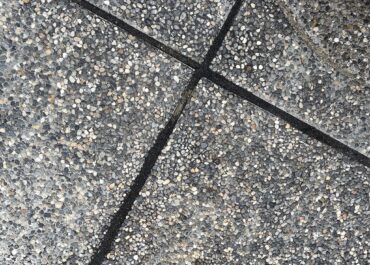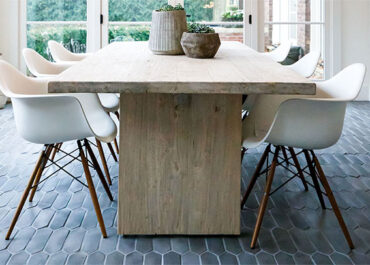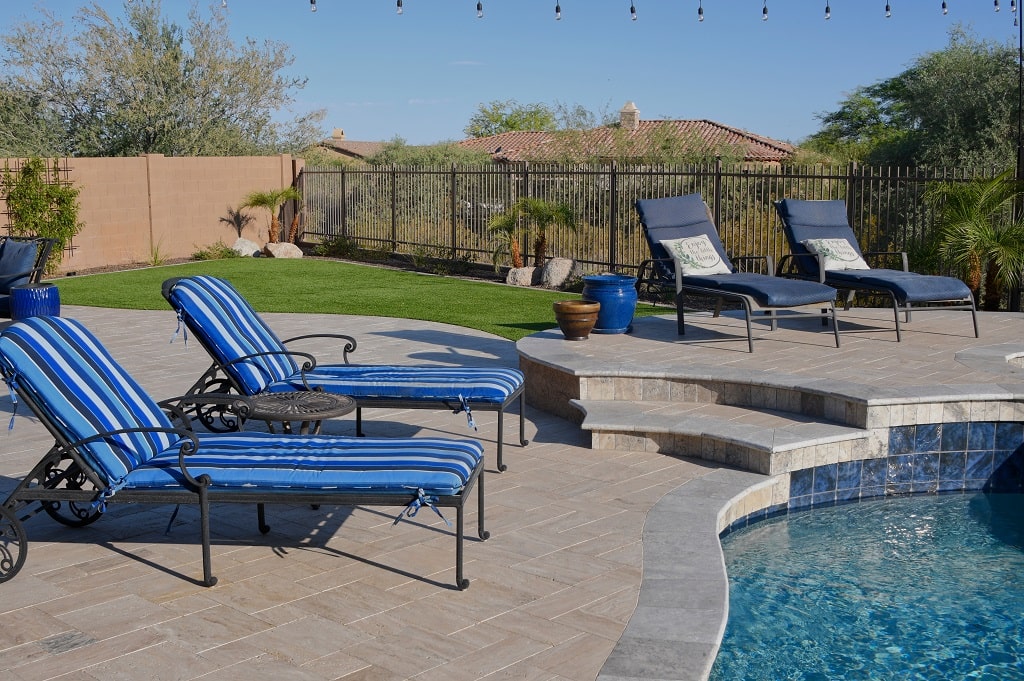
Hardscape design has never been more versatile than now. In a world of mass production, long-lasting materials such as brick, porcelain, and travertine are widely available to the public, and homeowners face a plethora of options to choose from when building their perfect homes. Pools, in particular, are a thought-provoking project that undergoes meticulous planning over several months, and the question of whether travertine pavers for a pool deck are worth it lingers on.
Why would travertine be so special, after all? Well, there’s a reason why it’s everywhere – literally. (Even the Roman Colosseum is made of it, believe it or not.)
In today’s article, we aim to answer this question in the best way possible: by showcasing the cost-benefit of travertine as a hardscape material, especially when compared to traditional pavers such as bricks and concrete.
Read as well: Permeable Pavers in Hardscape Design
Why travertine is a great investment in hardscape
Before choosing travertine pavers for a pool deck, it’s essential to understand why you’d use them anywhere else.
First of all, travertine is renowned for its classic appeal and lasting elegance. This sedimentary rock boasts distinctive texture and color variations that add character and warmth to any outdoor space. When used as a surface material for a pool deck, travertine offers a multitude of benefits that make it a worthwhile investment, including:
- Durability; travertine is exceptionally hard and can withstand the challenges posed by water exposure, freeze-thaw cycles, and heavy foot traffic. This longevity ensures that your pool deck remains stunning and functional for years to come.
- Slip resistance; safety around the pool is paramount. Travertine pavers come with a naturally textured surface that provides excellent slip resistance even when wet, reducing the risk of accidents.
- Heat resistance; under the scorching sun, travertine pavers remain cooler underfoot compared to many other materials. This heat-resistant property ensures a comfortable and enjoyable poolside experience for everyone who wants to have a fun time.
- Timeless aesthetics; travertine’s sophisticated appearance never goes out of style. Its soft, earthy tones complement various design options, making it easy to integrate with your existing outdoor decor or future design changes.
- Low maintenance; with regular sealing, travertine pavers are relatively easy to maintain. They are resistant to staining and can be cleaned with mild solutions, keeping your pool deck looking pristine effortlessly.
Pros of travertine pavers for a pool deck
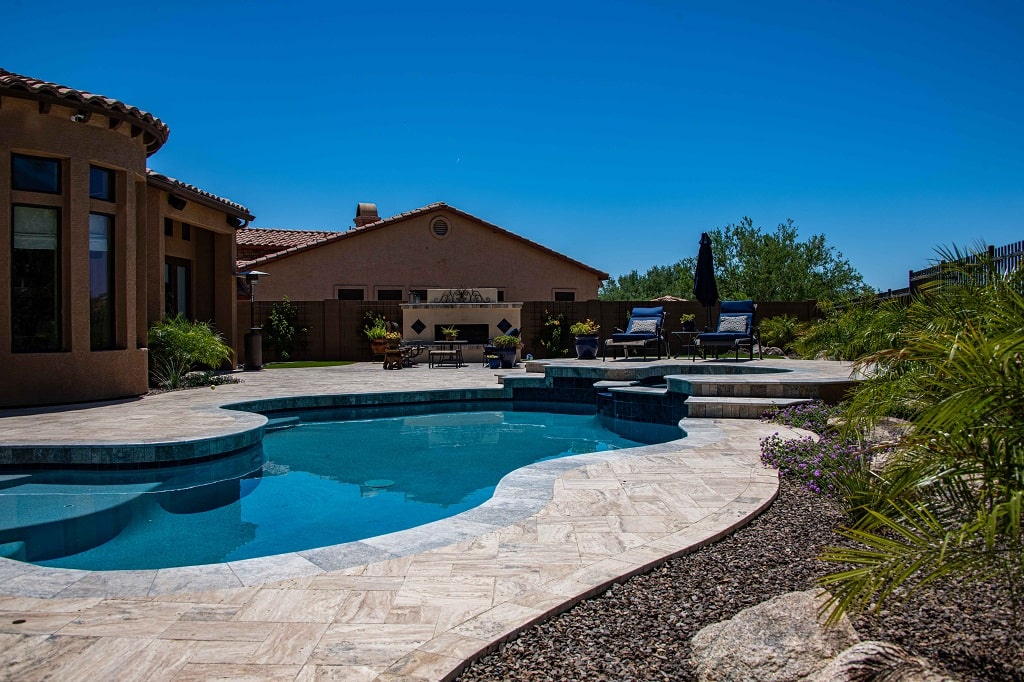
In this sense, travertine pavers for pool decks offer several long-term advantages, such as:
- Versatility; travertine comes in various shapes, sizes, and finishes, allowing you to customize your pool deck design according to your preferences.
- Comfort; as mentioned, the natural cooling properties of travertine make it comfortable to walk barefoot, even during hot summer days.
- Visual appeal; the rich and inviting appearance of travertine pavers elevates the aesthetics of your pool area, creating an upscale ambiance.
- Resistant to pool chemicals; travertine is resistant to the chemicals commonly found in pools, ensuring its integrity and longevity over time.
Cons of travertine pavers for a pool deck
That said, not everything is sunshine and flowers. While travertine pavers offer numerous benefits, it’s also important to consider potential drawbacks when choosing a permanent surface for a poolside:
- Cost: Travertine is a premium material – and its initial cost can be higher compared to other options. However, its long-term durability and timeless beauty can offset this expense.
- Porosity: Travertine is a porous material, which means it can absorb liquids if not properly sealed. Regular sealing is necessary to prevent staining – while relatively low-maintenance, travertine does require periodic sealing and cleaning to preserve its appearance and functionality.
The general cost of travertine pavers installation
You may be wondering how much of your budget is going to be necessary for this task. The bad news is that travertine is a natural stone (that, by the way, resembles marble a lot), so its price tag will go slightly up when compared to traditional pavers, such as bricks and concrete.
That said, the cost of installing travertine pavers for a pool deck can vary based on factors such as the quality of the stone, the size of the area, labor costs, and geographical location.
On average, you can expect to pay between $10 to $30 per square foot for the pallet and expert labor. However, keep in mind that while the initial investment might be higher compared to some other materials, the long-term benefits aforementioned make it a worthy investment.
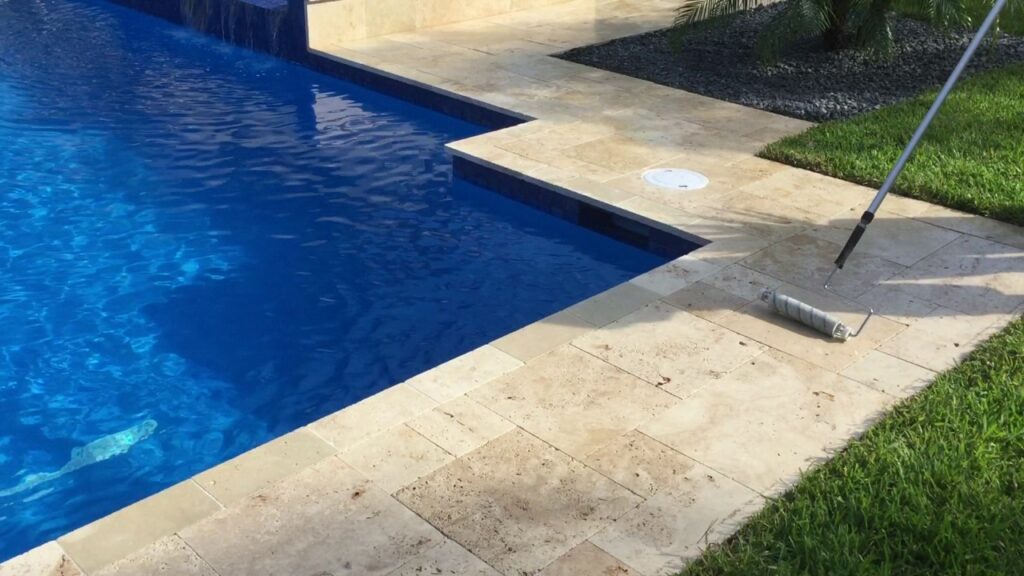
Check out a brief technical comparison between these three popular products on the market today:
| Brick Pavers | Concrete Pavers | Travertine Pavers | |
| Color and Design | Medium amount of options | A vast amount of options | Limited amount of options |
| Installation | Fairly difficult; requires sealing | Fairly difficult; requires sealing | Very difficult; requires sealing |
| Durability | Resistant to UV, prone to cracking | Highly resistant, but has a high UV absorption | Very resistant to UV, but prone to cracking and chipping |
| Price | $4 – $8 per square foot | $4 – $6 per square foot | $9 – $15 per square foot |
Don’t miss: Travertine vs Porcelain Pavers – A Simple Guide
How to choose my travertine pavers for a pool deck?
Now for some creative tips. Travertine is commonly used in neutral tones such as cream, beige, brown, gold, walnut, and tan. This variety of colors allows for different styles to be achieved.
- A silver travertine pool deck can incorporate grays into your outdoor space, reminiscent of an Old World look;
- An ivory travertine pool deck provides a clean look;
- A white travertine pool deck creates a luxurious marble-like facade.
Certain travertine finishes are smooth, while others offer more variation. The most popular choices for use outdoors include honed, chiseled, tumbled, and brushed. The material can also range in quality, which can be seen through its color and texture above all.
- Travertine pavers that have consistent coloration are often more expensive and considered “premium grade.” Color inconsistencies and gray or black markings are usually categorized as “commercial grade.”
- Travertine that’s smoother and doesn’t have holes to be artificially filled during the manufacturing process is a premium grade, while materials with large holes or gaps are commercial grade.
Remember – at the end of the day, consulting with a professional or a stone supplier can help address any specific questions or concerns you may have about using travertine pavers for your pool deck.
Do travertine pavers need to be sealed?
Well, the question of whether travertine pavers need to be sealed is a topic of debate among experts. Sealing can provide an added layer of protection against staining, moisture penetration, and fading. For travertine pavers used in pool applications, sealing can be particularly beneficial due to their exposure to chlorine and other pool chemicals – also enhancing the color and natural beauty of the stone.
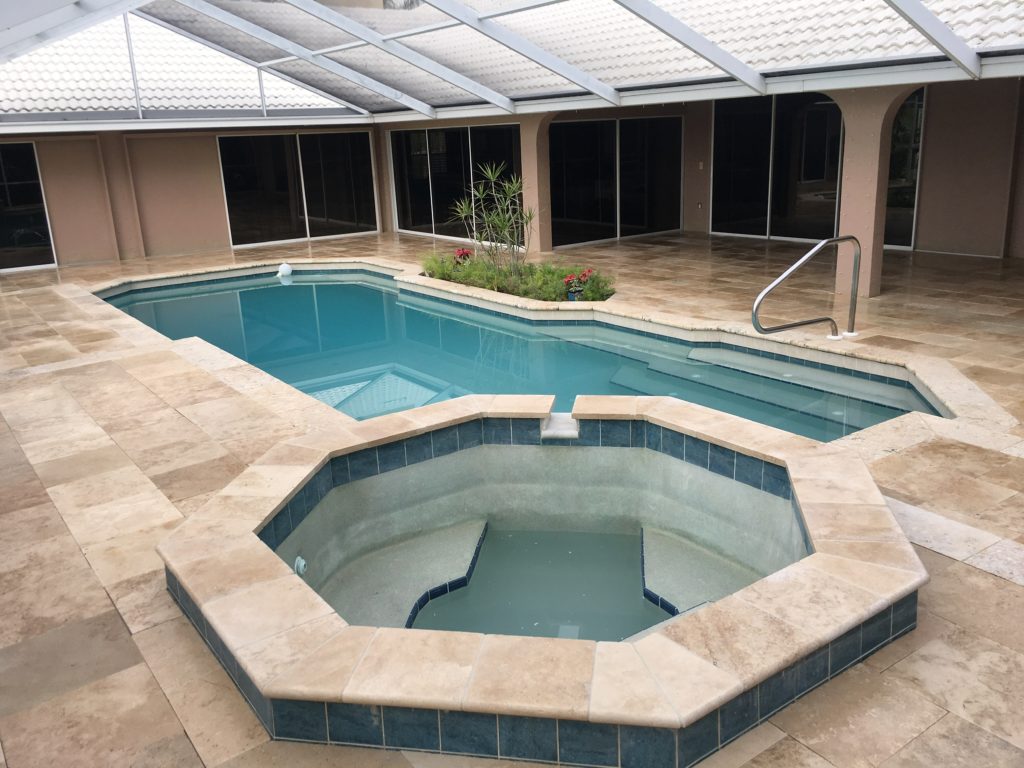
However, it’s important to note that sealing travertine pavers can also have potential drawbacks, especially in humid areas. One of the unique characteristics of travertine is its ability to absorb water, after all – and this porosity allows travertine to naturally regulate moisture and temperature, making it a popular choice for areas around pools where splashing water is common. This means that sealing them can potentially compromise this natural water-absorption property, leading to issues such as standing water on the surface or decreased traction when wet.
Not only that but improper sealing techniques or the use of low-quality sealers can exacerbate these problems, trapping moisture within the stone and potentially causing damage over time. In some cases, sealed travertine pavers near pools may become slippery when wet, posing a safety concern for those playing in the area – endangering nearby kids and elderly people.
Get an unlimited supply with Eagle Pavers!
So, have we helped you decide on the best material for your pool deck? As professionals in the business for years, trust us in this: there’s no margin of error with travertine pavers when it comes to wet areas.
As a branch of Eagle Stones, our team specializes in paver supply and installation around the county of Sarasota and Manatee, Florida. In case you’re near us, don’t hesitate to give us a call so we can get started on your project with a free estimate!

Click here to view the full online catalog – we’ll be waiting for you to reach out.
Frequently asked questions
Are travertine pavers slippery when wet?
Travertine pavers are naturally textured, which helps provide traction even when wet. This makes them relatively slip-resistant, enhancing safety around your pool area. However, it’s important to choose a finish that offers the right balance between texture and comfort.
How do I maintain travertine pavers on my pool deck?
Maintaining travertine pavers involves a few simple steps. Regularly sweep the surface to remove debris, and clean it with a mild soap solution or a specially formulated stone cleaner. Be sure to reseal the pavers every 1-2 years to prevent staining and maintain their overall appearance.
Can travertine pavers withstand the harsh chemicals used in pools?
Yes, travertine pavers are resistant to the chemicals commonly found in pools, such as chlorine. However, it’s still a good practice to rinse the pavers with clean water after exposure to pool water to prevent any chemical residue buildup.
Is travertine suitable for colder climates?
Travertine’s durability and resistance to freeze-thaw cycles make it suitable for colder climates. However, it’s important to choose a high-quality travertine with low water absorption to minimize the risk of damage due to freezing and thawing.


